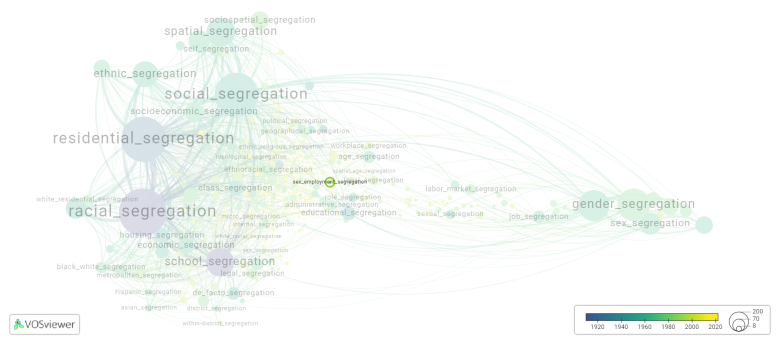Sex employment segregation: Difference between revisions
(Creating page) |
(Creating page) |
||
| (5 intermediate revisions by the same user not shown) | |||
| Line 12: | Line 12: | ||
Efforts to reduce sex employment segregation focus on promoting gender equality and challenging traditional gender roles. This includes advocating for policies and initiatives that promote diversity and inclusion in the workplace, addressing gender-based discrimination, and encouraging individuals to pursue careers based on their interests and abilities rather than societal expectations. | Efforts to reduce sex employment segregation focus on promoting gender equality and challenging traditional gender roles. This includes advocating for policies and initiatives that promote diversity and inclusion in the workplace, addressing gender-based discrimination, and encouraging individuals to pursue careers based on their interests and abilities rather than societal expectations. | ||
==See also== | ==See also== | ||
==Related segregation forms== | |||
Sex employment segregation is frequently discussed in the literature with the following segregation forms: | |||
[[social segregation]], [[employment segregation]] | |||
[[File:sex_employment_segregation.png|780x780px]] | |||
This visualization is based on the study [[Segregation_Wiki:About| The Multidisciplinary Landscape of Segregation Research]]. | |||
For the complete network of interrelated segregation forms, please refer to: | |||
* [https://tinyurl.com/2235lkhw First year of publication] | |||
* [https://tinyurl.com/2d8wg5n3 Louvain clusters] | |||
* [https://tinyurl.com/223udk5r Betweenness centrality] | |||
* [https://tinyurl.com/244d8unz Disciplines in which segregation forms first emerged (Scopus database).] | |||
==References== | ==References== | ||
==Notes== | ==Notes== | ||
<references /> | <references /> | ||
{{NoteAI}} | {{NoteAI}} | ||
==Sex | ==Sex employment segregation appears in the following literature== | ||
Kaufman R.L. (2002). Assessing alternative perspectives on race and sex employment segregation. ''American Sociological Review'', ''67''(4), 547-572. American Sociological Association.https://doi.org/10.2307/3088945 | Kaufman R.L. (2002). Assessing alternative perspectives on race and sex employment segregation. ''American Sociological Review'', ''67''(4), 547-572. American Sociological Association.https://doi.org/10.2307/3088945 | ||
Latest revision as of 07:17, 16 October 2024
Date and country of first publication[1][edit | edit source]
2002
United States
Definition[edit | edit source]
Sex employment segregation refers to the separation of individuals into different occupations or industries based on their biological sex or gender. It refers to the tendency for men and women to be concentrated in different types of jobs, with women being overrepresented in traditionally female-dominated occupations and men being overrepresented in traditionally male-dominated occupations.
This segregation is often perpetuated by societal expectations, cultural norms, and discrimination, leading to a lack of opportunities for individuals to pursue careers outside of traditional gender roles. It can also result in gender pay gaps and disparities in career advancement.
There are various reasons for sex employment segregation, including stereotypes, biases, and societal expectations regarding the roles and capabilities of men and women. these biases and stereotypes can discourage individuals from pursuing careers that are perceived to be outside of their gender norm, which in turn perpetuates the segregation.
Efforts to reduce sex employment segregation focus on promoting gender equality and challenging traditional gender roles. This includes advocating for policies and initiatives that promote diversity and inclusion in the workplace, addressing gender-based discrimination, and encouraging individuals to pursue careers based on their interests and abilities rather than societal expectations.
See also[edit | edit source]
Related segregation forms[edit | edit source]
Sex employment segregation is frequently discussed in the literature with the following segregation forms:
social segregation, employment segregation

This visualization is based on the study The Multidisciplinary Landscape of Segregation Research.
For the complete network of interrelated segregation forms, please refer to:
References[edit | edit source]
Notes[edit | edit source]
- ↑ Date and country of first publication as informed by the Scopus database (December 2023).
At its current state, this definition has been generated by a Large Language Model (LLM) so far without review by an independent researcher or a member of the curating team of segregation experts that keep the Segregation Wiki online. While we strive for accuracy, we cannot guarantee its reliability, completeness and timeliness. Please use this content with caution and verify information as needed. Also, feel free to improve on the definition as you see fit, including the use of references and other informational resources. We value your input in enhancing the quality and accuracy of the definitions of segregation forms collectively offered in the Segregation Wiki ©.
Sex employment segregation appears in the following literature[edit | edit source]
Kaufman R.L. (2002). Assessing alternative perspectives on race and sex employment segregation. American Sociological Review, 67(4), 547-572. American Sociological Association.https://doi.org/10.2307/3088945
